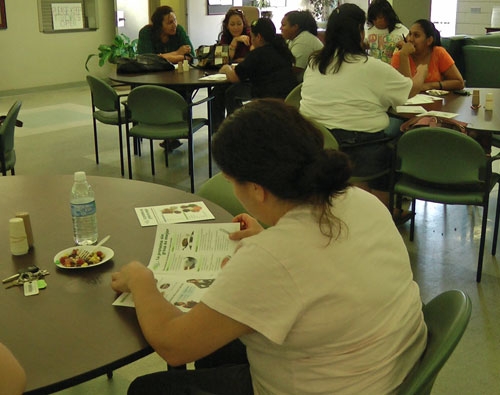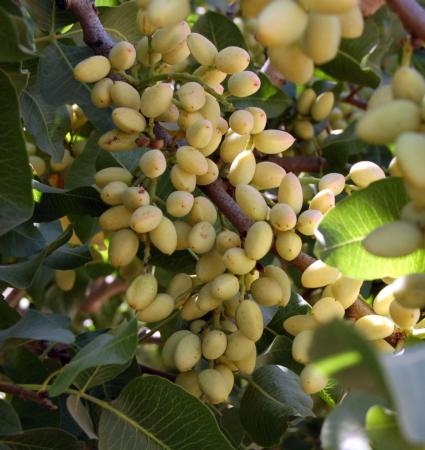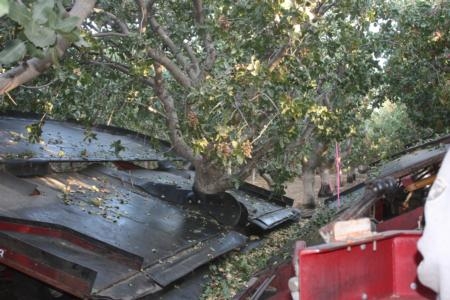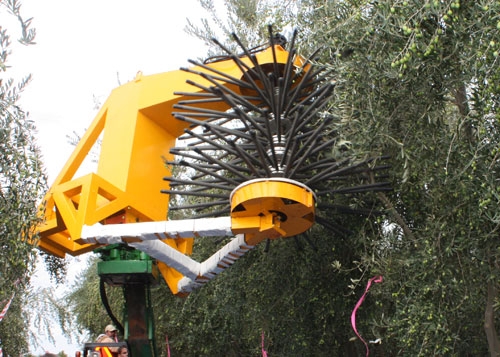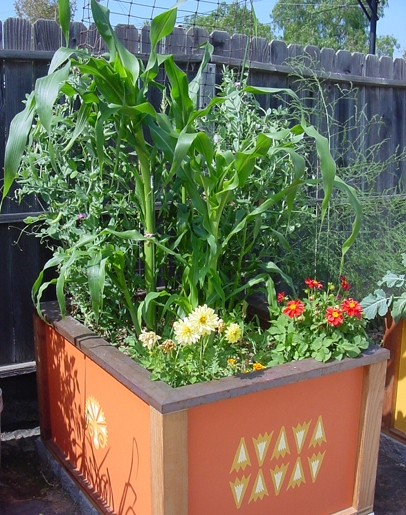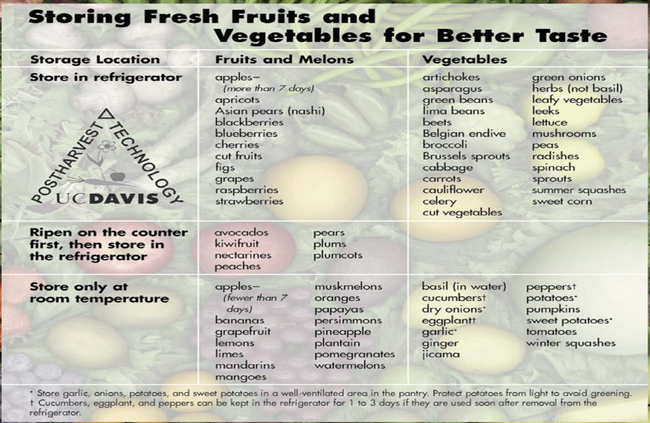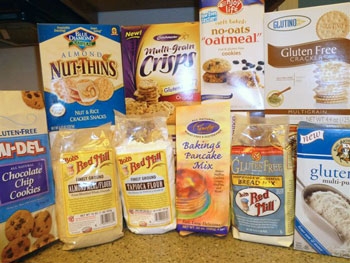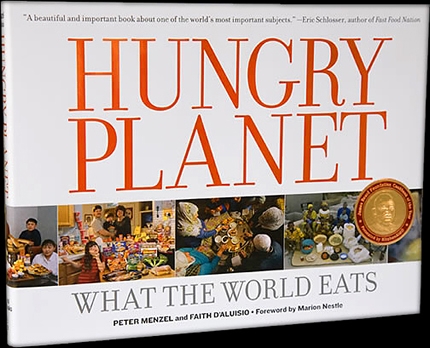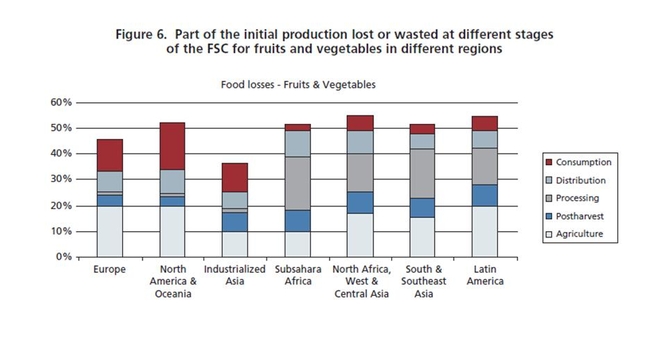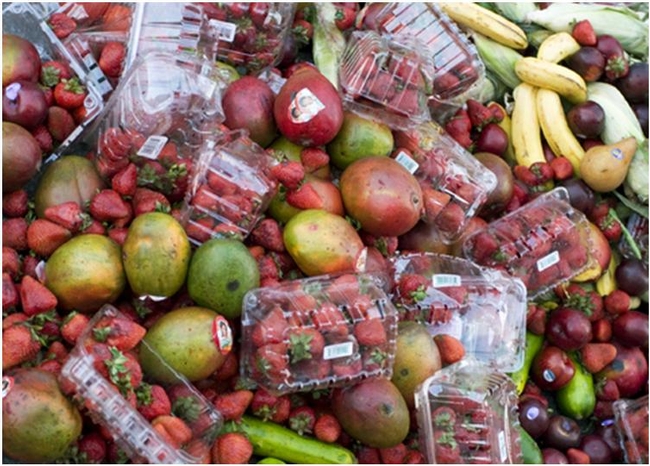UC Food Blog
For best results, kids and parents both need nutrition education
UC Cooperative Extension has found a health and fitness formula that works. Combining fun exercise and nutrition classes for kids with special sessions for parents melts away pounds and inches.
The concept was proven successful at a day camp offered by the City of Fresno Parks and Recreation and Fresno County UC Cooperative Extension this summer. About 90 overweight or obese children were recruited to participate in the six-week program at Ted C. Wills Community Center and Holmes Playground. Their parents attended two mandatory evening meetings a week.
In all, the campers lost 241 pounds. More significantly, a combined 253 centimeters was erased from the children’s waistlines. The number of pounds lost is skewed by the fact that some of the children grew taller during the summer. The number of waistline inches lost reflects improved muscle tone.
“Without involving parents, it is very difficult for children to make changes in food choices,” said Sara Bosse, the nutrition education manager for UC Cooperative Extension in Fresno County. “Parents are the ones doing the shopping and preparing meals. If the children don’t have the opportunity to practice what they learned at home, their efforts are going to be sabotaged.”
The children gathered five days a week to learn about and taste fruits and vegetables prepared in several different ways. The recipes were shared with parents at the evening meetings, where they also had the opportunity to try some prepared dishes.
“With exposure to the food in different manners, they gain acceptance to fruits and vegetables that they didn’t like before,” Bosse said.
The children also participated in physical activities and maintained journals in which they chronicled their evolving tastes for healthy food.
Previous research has shown that children typically gain more weight in the summertime than they do during the school year.
“If kids aren’t involved in a program, they may be just sitting at home and getting bored and eating more,” Bosse said.
This year’s project shows how that trend can be reversed.
View a video of a healthy fitness camp parent meeting featuring UC Cooperative Extension nutrition program coordinator Angelita Zaragoza below.
Read a transcript of the video.
Following is the recipe:
Vegetable and tofu stirfry
Ingredients:
1 tablespoon vegetable oil
4 ounces firm tofu cut into small cubes
1 14 ounce can diced tomatoes
5 cuts cut up vegetables, fresh or frozen, such as broccoli, bell peppers, cauliflower, sugar snap peas, carrots, etc.
2 cups broth
2 tablespoons corn starch
1 teaspoon garlic powder
A pinch of pepper
2 tablespoons soy sauce
6 cups cooked brown rice
Instructions:
Sauté tofu in oil until lightly browned. Add the rest of the ingredients, except the rice. Bring to a boil, then simmer for 10 minutes or until the vegetables are tender. Serve on cooked brown rice.
Angelita
Pistachio harvest: Wait, split, GO!
“Pistachio is a funny kind of nut,” says UC pomologist Louise Ferguson. With other nuts, the shell grows and hardens as the kernel develops, whereas pistachio grows its shell first, hardens it, and then plumps up a kernel inside. As early perhaps as Labor Day, when growers are always hopeful the harvest can begin, it will be seen whether the nuts in the millions of trees in California orchards have formed well.
Tension is rising. In these last hot days of August, as the nuts reach maturity, the shells must split. If too many of them don’t, the harvest will be much less profitable, because it’s hard to make a natural-looking split in a pistachio shell with a machine, and unsplit pistachios bring a lower return. Growers are watching the split percentages carefully; wait too long for the highest number and navel orange worms have a larger window of opportunity to lay eggs along the sutures.
Pistachio orchards are harvested mechanically, and the machines are generally owned by contractors, though a large farm may have its own. As soon as the first machine enters the first orchard — the greatest acreage is on the west side of the San Joaquin Valley, around Bakersfield — a race begins.
“It’s chaotic,” says Ferguson. For more than 15 hours every day, beginning before dawn and finishing at dark, the harvesters speed through tunnels of dust and noise up and down orchard rows, followed by bank-out wagons that must get the nuts to the processing plant for drying before the day is out. Each wagon holds 55,000 pounds of pistachios. Left too long in the heat, under the weight of such a load, the pink hulls (each nutshell is within a hull) degrade and stain the shells a darker shade, which lowers the nuts’ value. The California pistachio industry prides itself on producing a large, naturally split, light shelled nut with no artificial splitting or bleaching.
The race gets more fraught each year because contractors have significantly more and more acreage to harvest within the six-week harvest season. Ferguson calls pistachio the “single most successful plant introduction in the 20th century.” The California crop has grown from zero to approaching a quarter million acres in 40 years.
Ferguson knows all about the harvesters, because they are no longer working well as the trees age. It’s her job to develop a harvester that does. The standard pistachio harvester is a trunk shaker: it has two units, one each side of the tree row, which travel together, lock onto a tree trunk, and shake it for 4 to 8 seconds so that nuts fall into the catch frame — resembling huge wing structures — that the units place beneath the tree canopy. The catch frame flicks the nuts into the conveyor belt at the base of the frame, which takes them to the back of the harvester, where they are conveyed through an air leg to remove debris out to the wagon while the harvester keeps moving from tree to tree.
Mature trees have thicker trunks that don’t shake as well, and the trees are now so large, “some nuts can go flying over the catch frame,” says Ferguson. She has trials under way with a direct-canopy-contact harvester. “It’s like a big hairbrush,” she says, that ruffles the tree canopy to get the nuts out of the tree.
Her colleagues at UC Davis are breeding varieties with a more reliable split and a very early or very late harvest date to spread out the season. Meanwhile, the chaos goes on. This year, because of the cool spring, Ferguson suspects the nuts will split over an extended time period, so growers may well decide to harvest once, then a few weeks later get the harvesters back for a second time.
See a tree shaker harvesting pistachio nuts below. (Video provided by Coe Orchard Equipment.)
Pistachio harvest
From 'backyard to belly'
So you may have heard of ”farm to fork” or “farm to table”? Well, I like to think even more locally than that. I think in terms of “backyard to belly” . . . food so fresh you can eat it while standing in the garden without cooking it or with a little more effort, carrying a basket of fresh tomatoes, zucchini, peppers, eggplants, peaches, corn and beans into the kitchen to create wonderful meals for your family.
I have a few tips on getting quality food from your harvest. So often we lose a lot of our homegrown produce because we don’t harvest at the right time. It is important to harvest at the peak of perfection - not before and not after. My worst food experiences from my garden have come from waiting too long to harvest. The corn gets starchy (and the corn earworms get more of the kernels than I do), the beans get tough, the melons, when overripe, are not even worth cutting open and peaches will not hold up well when they are cooked or canned. To be a good gardener and a good chef of ”backyard to belly” foods, you really have to stay on top of the harvest and not let it get ahead of you. I know that if you work full time, you just may not have the time to harvest when you need to, but if you don’t take the time, then you have pretty much wasted your time and garden resources.
One thing that can help is to invest in a separate cold storage system, I call it my “fruit fridge” (just a used refrigerator in the garage), in which you can store your harvested produce until you can process it either by cooking, or for longer term storage canning, freezing or drying. Your regular household refrigerator will work just fine but often there is too much produce and you won’t have enough room. Refrigeration will help to keep the produce fresh longer and allow you a little more time to process. For example, I have too much corn ready at one time. Corn is best eaten within a few hours after harvest since the conversion to starch occurs quickly. While it would be fun to have a corn feed or share with all my neighbors, I really would like to store some for the winter. I harvest my corn so that it is just mature but not too mature. Typically, the ears will be filled with kernels and the tips of the silks will begin to dry out. The “milk” from the kernels should be clear and not white. After harvest, I quickly move the ears to the refrigerator since that slows the conversion rate of sugar to starch. When I have time within the next day or so, I will prep them for freezing. The sooner you can process the corn, the better the quality will be.
Peaches are another crop that tends to be ready at one time. One thing I do is write the approximate harvest date in my calendar for the next year so I won’t schedule a vacation during the harvest period. Second, peaches are best harvested for longer term storage (canning, freezing and drying), when they are fully ripe but still firm. You can then leave them on the counter until they are at the stage you prefer them at for fresh eating. If you intend to can, freeze or dry the fruit, it is best to process them shortly after harvest. If you have to wait to process, then store them in your fruit fridge until you are ready, but you should do it within a few days.
If you want more information on proper harvesting and storage of home garden vegetables and fruits, visit these pages on The California Garden Web and The California Backyard Orchard. If you are new to preserving foods, The National Center on Food Preservation has free guidelines for you.
You may also want to visit the Postharvest Technology Center webpage for more information on storing fresh fruits and vegetables for better taste.
Trying gluten-free: trials, tribulations and successes
For the past 10 weeks we have been experimenting with a gluten-free diet. The primary household beneficiary of this dietary scheme was already very thin, and his favorite foods, wouldn’t you know it, were gluten-ladened items such as donuts, cinnamon rolls, pancakes, and toasted English muffins.
Researching gluten-free recipes has unearthed a wealth of information about various ways to prepare these favorite items, made without gluten, so they taste and look good. Usually, simple substitution of gluten-free flours for wheat flour tends to render traditional recipes either too wet or too dry, crumbly, tough or tasteless. We learned that the addition of a small amount of xanthan or guar gum helps to thicken and bind together the ingredients for a more palatable texture, and additional flavorings really help liven up gluten-free flours. Our first batch of cinnamon rolls were dense, tough and refused to brown, the second had better taste and texture but still didn’t look very appetizing.
Another challenge has been that of finding out if grocery items might have gluten hidden in them. As we sleuth through micro-font labels, looking for ingredients such as “malt”, “soy sauce” or “hydrolyzed vegetable protein,” many an item doesn’t get placed into the shopping cart due to an offending ingredient. On the positive side, we have been tickled to find, tucked away in previously undiscovered niches of our favorite markets, a decent selection of gluten-free foods. Even Betty Crocker has come up with Gluten-Free Bisquick, which we were happy to discover at a small Garberville market during a camping trip to the Redwoods.
Restaurant dining, take out, and even eating at a friend’s house requires advance planning and research, with sometimes the need for creative solutions. Yesterday at my sister’s house, build-your-own deli sandwiches were the main item on the lunch menu, so I asked if she happened to have any corn tortillas. Voila! A wrap was enjoyed just as much as a sandwich.
We’ve had some successful forays into recipe adaptation, and found some very helpful online resources that have helped us learn why an adapted recipe has not succeeded and how to make it better the next time. I expect that by this time next summer we’ll have a good assortment of new favorite recipes, tasty “GF” products, and restaurant options.
Chocolate Beanie Cake (Gluten Free)
12 oz. semi-sweet chocolate chips
15 oz. can garbanzo beans (chick-peas) rinse well and drain
4 eggs, separated
¾ c. granulated sugar
¾ tsp. baking powder
1/8 tsp. salt
Directions:
- Preheat the oven to 350 degrees F.
- Grease and flour a round 9 inch cake pan (or spring form pan)
- Melt chocolate chips in a microwave-safe bowl (at 70% power if possible) for approximately 3 minutes, stirring every 30 seconds. Stop cooking when chocolate is smooth and completely melted.
- Separate eggs, set the whites aside. In food processor, process beans and egg yolks until very smooth. Add in the sugar, baking powder and salt, and pulse food processor to blend. Pour in the melted chocolate and blend until all ingredients are well mixed.
- Beat egg whites with a mixer until stiff, fold gently by hand into chocolate/bean mixture until well mixed.
- Pour batter into the prepared cake pan, bake 40 minutes in preheated oven, or until cake tester inserted in center of cake comes out clean. Cool on a wire rack for 15 minutes before inverting onto a serving tray.
Good drizzled with raspberry syrup, chocolate syrup, and served slightly warm.
Note: Gluten is found in wheat, barley, rye, and sometimes oats.
It's just a waste
What got me started on this contribution is a book I recently read, called Hungry Planet by Peter Menzel and Faith D’Aluisio. It photo-chronicles what an average family from different regions around the world eats in a week. Fascinating reading, but not the topic of this blog, just the inspiration.
I’m writing about food waste, specifically fresh fruits and vegetables. First let’s look at the facts. In a 2011 report commissioned by the Food and Agriculture Organization, it was found that “Roughly one third of the food produced in the world for human consumption every year — approximately 1.3 billion tons — gets lost or wasted.”
The report does distinguish between loss and waste, pointing out that losses, which occur in production, harvest, postharvest and processing, are most prevalent in developing countries, whereas waste, which occurs at the end of the processing phase, is due to poor distribution and consumption habits, found in the industrialized countries. In developing countries, 40 percent of losses occur at post-harvest and processing levels while in industrialized countries more than 40 percent of losses happen at retail and consumer levels.
The report also points out that per capita waste by consumers is approximately 10 times greater in Europe and North America than it is in sub-Saharan Africa and South and Southeast Asia. Not surprising, just hard to hear.
We aren’t only wasting food when we throw out our fruits and vegetables. It takes time, money, energy, water and oil to generate produce. In fact, an article written for The Economist states, “Producing these wasted calories accounts for more than one-quarter of America’s consumption of fresh water, and also uses about 300 million barrels of oil a year.”
And, if that’s not enough what about the time and gas required to take it from the farm to the packing house to the shipper to the store to the home to the dump? And once it’s at the dump, rotting fruits and vegetables produce methane, a greenhouse gas 20 times more potent than carbon dioxide.
OK, OK enough with the lecture. What can we do?
- Raise your awareness of waste
- Assess what you have on hand before buying more
- Plan your meals and shop with a list to reduce over-purchasing (and go to the store with a full stomach!)
- Organize your fridge and counter so you know what you have
- Cook so that you don’t have too many leftovers
- Use your freezer
- Get creative with any remaining fruits and vegetables — recipes are abundant online
- Compost leftovers so you can grow your own fruits and vegetables


